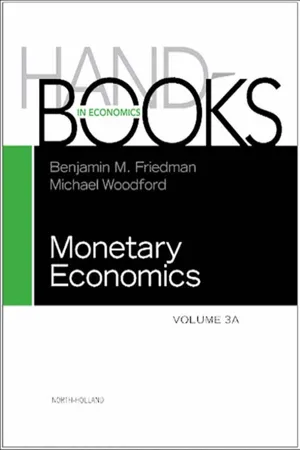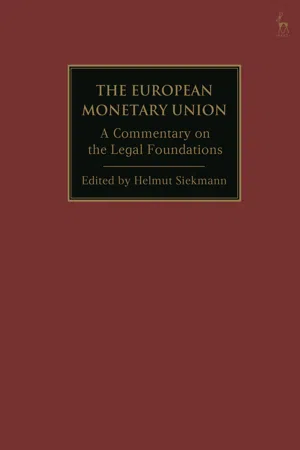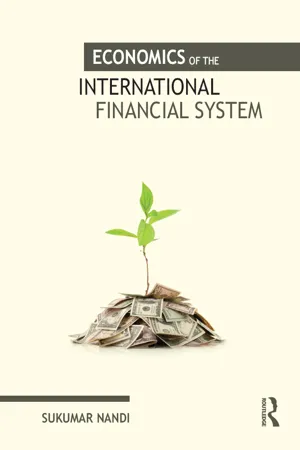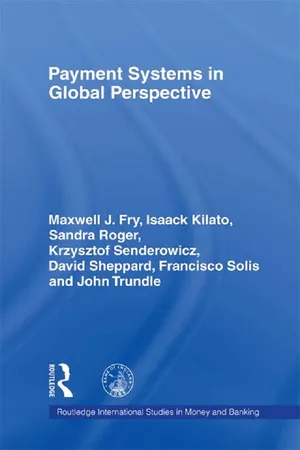Economics
Market for Reserves
The market for reserves refers to the interbank market where banks lend and borrow reserves from each other to meet reserve requirements set by central banks. This market helps banks manage their liquidity and ensure they have enough reserves to meet regulatory requirements. The interest rate in the market for reserves, known as the federal funds rate in the United States, is a key tool used by central banks to implement monetary policy.
Written by Perlego with AI-assistance
Related key terms
7 Key excerpts on "Market for Reserves"
- eBook - ePub
- Benjamin M. Friedman, Michael Woodford(Authors)
- 2010(Publication Date)
- North Holland(Publisher)
On the supply side of the market, a central bank operating as the Federal Reserve or the BOJ did before 2008 is implicitly committing to intervene as necessary, also on a daily basis, to keep the policy interest rate within some unstated bounds of its target. A central bank operating as the ECB did before 2008 has an explicit commitment to provide or absorb reserves in unlimited quantity at the interest rates on the two standing facilities, together with some presumably lesser (because it occurs only once per week) commitment to intervene within those bounds. A key implication of the resulting interaction, on the assumption that banks understand the central bank's operating system and anticipate its actions, is a daily reserve demand function that depends on the difference between the market rate and the target rate even if the reserve demand is inelastic with respect to the level of either rate. 53 It is this feature that, in effect, gives the central bank the ability to shift the reserve demand schedule as illustrated in Figure 6. The three-asset demand and supply model developed in Section 3 provides a useful way to formalize these relationships. While the resulting model does not incorporate many of the complexities and unique features of individual central banks' operating frameworks, it nonetheless captures the essential features that give rise to the anticipation effect. The key point is that, because the reserve requirement applies not to each day separately but on average over the maintenance period, banks' demand for reserves on day t depends not only on the current configuration of interest rates, as in Eq. (3), but also on the expected future rate for borrowing or lending reserves - eBook - ePub
The European Monetary Union
A Commentary on the Legal Foundations
- Helmut Siekmann, Helmut Siekmann(Authors)
- 2021(Publication Date)
- Hart Publishing(Publisher)
93 The Bundesbank Act in the version valid until the end of 1998 contained rules regarding minimum reserve requirements and can be seen as an inspiration for comparable rules contained in Article 19.10 Besides the Deutsche Bundesbank, a number of other central banks of Member States of the Union,11 as well as the Federal Reserve12 and the Bank of Japan,13 used or use minimum reserve requirements as a standard monetary policy instrument.144 Article 19.1 (not the competences of the Council pursuant to Article 19.2) can be amended by the simplified amendment procedure according to Article 129.3 TFEU (Article 40.1 Statute).B. General SignificanceI. Objectives and Relevance of Minimum Reserve Requirements5 Minimum reserve requirements are a standard Eurosystem monetary policy tool for the performance of money market management and monetary control functions.15 They aim at stabilising money market interest rates and creating or enlarging a structural liquidity shortage (structural deficit of central bank liquidity).16 By giving institutions an incentive to smooth the effects of temporary liquidity fluctuations, the “average principle”17 of the Eurosystem minimum reserve system supports the stabilisation of money market interest rates.18 The “average principle” also prevents a strong volatility of the overnight rate as it enables institutions to satisfy short-term demands on central bank liquidity with their minimum reserve holdings.19 Minimum reserve requirements also ensure the dependency of credit institutions on central bank refinancing operations by increasing the demand for central bank liquidity.20 This demand facilitates the conduction of monetary policy, e.g. to steer money market rates through regular liquidity-providing operations.21 An intended side effect is the increase of the institutions’ liquidity (and solvency) by means of their reserve holdings, even though the banking supervisory law provides increasingly detailed requirements on the institutions’ liquidity ratios.22 - eBook - ePub
- International Monetary Fund(Author)
- 1996(Publication Date)
- INTERNATIONAL MONETARY FUND(Publisher)
5 The Role of Reserves in the International Monetary System
Michael P. Dooley *T HE ANALYSIS OF THE ROLE OF RESERVES in the monetary system has generally focused on the demand for reserves. That is, the decisions of individual countries to hold various types of reserve assets and changes in these preferences are seen as affecting prices and economic activity in the world economy. One well-known conclusion of this type of research is that the demand for reserves has apparently not changed significantly in recent years despite very important changes in exchange rate regimes, international capital markets, and a number of other institutional developments.1 The apparent stability in demand for reserves might suggest that the role of reserves in the system has also not changed greatly.The argument presented in this paper, however, is that, although the demand for reserves may appear to be little changed, the role of reserves in the current system is fundamentally different because the systemic constraints on the supply of reserves has changed. By concentrating on the demand for reserves, analysts have implicitly assumed that the supply of reserves is determined independently of economic policies of individual countries. As a result, governments’ reactions to an exogenous change in the supply of reserves in part determines the course of important economic variables such as employment and prices. This assumption may have been appropriate under past international monetary arrangements but continued reliance on this assumption can be seriously misleading.An alternative framework is based on the assumption that each country faces a schedule that determines the terms under which reserves are supplied to that country. In most cases the relevant supply conditions are the terms on which the country can obtain credit in international financial markets. Thus, reserve holdings are, for most countries, seen as one aspect of an increasingly sophisticated strategy of financial management. This framework also suggests that reserves, per se, play a much more important role in the policies of countries that are effectively excluded from participating in private financial markets. For unconstrained countries, the cost of holding reserves can be compared to the spread between the marginal cost of obtaining credit and the rate of return earned on their reserve assets. For countries with limited or no access to credit markets the cost of obtaining reserves is related to the requirement that their net receipts from goods and services traded with the rest of the world be altered. - eBook - ePub
Central Bank Autonomy
The Federal Reserve System in American Politics
- Kevin Corder(Author)
- 2014(Publication Date)
- Routledge(Publisher)
CHAPTER 3 Reserve Requirements and the Distribution of Monetary RestraintReserve requirements specify the percentage of commercial bank liabilities that must be held at the Federal Reserve regional banks in order to meet demands of depositors or other claims against commercial banks. The requirements obligate a financial institution to place funds in a reserve account at a regional Federal Reserve Bank. Since the reserve accounts yield no interest, financial institutions realize no return on bank assets that serve as reserves. Any profits generated by the investment of the contents of these reserve accounts in government securities is held by the Fed, so reserve requirements redistribute revenue from commercial banks to the regional Federal Reserve Banks. Required reserves therefore function as an implicit tax on the financial institutions to which they apply.Studies of monetary policy outcomes by political scientists and political economists typically have as a singular focus the extent to which central bank policies expand or contract the aggregate supply of credit and money available to finance economic activity. Indicators of expansion and contraction include aggregate nonborrowed commercial bank reserves, the federal funds rate, and the narrow money aggregate (M1). In this context, reserve requirements are either high (meaning tighter money) or low (meaning easier money). Little attention is given to variation in the scope and definition of required reserves. This omission is surprising given the distributive implications of changes in reserve requirements. Since the structure of reserve requirements determines the distribution of an implicit tax burden across types and classes of financial institutions, changes in reserve requirements are ultimately redistributive choices. It would seem to matter to both commercial bankers and elected officials whether or not, for instance, bank holdings other than deposits at a Federal Reserve Bank can be counted as cash reserves. Banks that routinely hold large amounts of vault cash, at one time characteristic of rural banks, would be disadvantaged if those assets could not be counted as reserves. Since important redistributive effects accompany changes in reserve requirements, these changes should attract considerable attention from members of Congress. Reserve requirements determine what types of financial institutions are most directly affected by monetary restraint and what types of borrowers face the dearest interest rate premiums when monetary policy is tightened. Elected officials are likely to have preferences over how monetary policy is distributed across the economy, so reserve requirements could be a focus of efforts by elected officials to influence monetary policy outcomes. Fed policy makers, reflecting a systematic strategy of avoiding congressional intervention in monetary policy choices, consistently rely on indirect rules and administrative updates (rather than statutory instructions) to manage reserve requirements. - eBook - ePub
- Sukumar Nandi(Author)
- 2017(Publication Date)
- Routledge India(Publisher)
Since the late 1950s, many papers have been written on the theme of international reserve, and these come under broadly two categories: The world reserve problem and how the IMF would solve the problem of inadequate world-level liquidity, so that rising trade among the member countries are not adversely affected; the second channel of research continued regarding the optimal level of reserve from the stand point of a single country. The latter problem has assumed importance in view of the floating exchange rate regime established after the collapse of the Bretton Woods Agreement in the early 1970s. There are at least eight reviews of the literature on the subject since 1960 and these are: Clower and Lipsey(1968), Niehans (1970), Salant (1970), Grubel (1970), Williamson (1973), Aizenman and Marion (2003), and Aizenman and Lee (2007).Almost all the studies explain that countries hold international reserve so that they can meet sudden temporary excess demand for foreign exchange and/or to meet short-run adjustment in the balance of trade. The central banks often intervene in the foreign reserve market by selling/buying foreign exchange. International reserves are defined to be assets or credits which can be used directly for intervention, or which can be converted into foreign exchange quickly and with certainty. In practice, it has been necessary to pick up arbitrary cut-off point on such a scale, and define international reserve as assets which are acceptable at all times to foreign economic agents (Machlup, 1966). IMF has to forward estimates of international reserve and these estimates have been widely used in literature for different purposes (Clark, 1971; Flanders, 1971; Kelly, 1970).A country can have international reserve at the macro level and also private liabilities towards foreign exchange. Some authors consider whether international reserve should be adjusted for such private liabilities (Brown, 1964; Kenen and Yudin, 1967). In the monetary theory literature, portfolio theory and financial intermediation have been developed and these tools have been used to explain the movement of international reserve in Kane (1965). Such a framework has some relevance with the discussion in Machlup (1966) and the studies of reserve assets composition (Hageman, 1969; Kenen, 1963). The portfolio model employed in Hageman computed stock-adjustment equation for 11 major countries on quarterly data of the 1950s and early 1960 and the study found good evidence that adjustment was far from instantaneous. - eBook - ePub
- Maxwell J. Fry(Author)
- 1999(Publication Date)
- Routledge(Publisher)
Chapter 5Reserve Requirements, Liquidity and Risk
5.1Introduction
IN RECENT YEARS, REQUIRED RESERVES have been reduced or eliminated in many countries, particularly transitional economies, to remove resource allocation distortions and to counteract financial disintermediation. For example, the ratio of bank reserves to bank deposits fell from over 50 percent to under 20 percent in Estonia, 1991–1996, from 25 to 15 percent in Lithuania, 1993–1995, from 35 to 10 percent in Poland, 1988–1996, from 26 to 18 percent in Russia, 1993–1996, and from 80 to 18 percent in the Ukraine, 1992–1997 (International Financial Statistics, CD-ROM, March 1997).To the extent that required reserves can be used during the day for payment purposes, they provide a costless source of liquidity. But noninterest-earning required reserves impose negative effective protection on a country's financial system so encouraging residents to use cheaper financial intermediation services abroad. International competition is therefore forcing monetary authorities to reduce the burden of reserve requirements either by lowering ratios or by paying interest on such reserves. At the same time, RTGS systems have been introduced in many industrial, transitional and developing countries both to eliminate settlement risk from high-value payment systems and to reduce moral hazard.These two tendencies create potential friction: the former diminishes demand for reserves to be kept overnight and the latter increases demand for reserves during the day. This conflict may encourage banks to spend too much effort from the social welfare viewpoint in managing their reserves. This chapter describes and discusses ways of dealing with these opposing forces, particularly as they apply to transitional and developing countries. - eBook - ePub
- Jagdish Handa(Author)
- 2002(Publication Date)
- Routledge(Publisher)
Canada has experimented with two different methods for setting the bank rate at which it lends to the chartered banks. Under a fixed bank rate regime adopted during 1956 to 1962 and 1980 to 1994, the bank rate was automatically set each week at 0.25% higher than the average Treasury bill rate that week. Since it was higher than the Treasury bill rate, the chartered banks incurred a loss if they financed their purchases of Treasury bills by borrowing from the Bank of Canada. Such a rate is said to be a ‘penalty rate’ and, by its nature, discourages borrowings. It does not, therefore, need the support of other restrictions on borrowings to the extent that the American discount rate requires. Since 1994, the Bank of Canada has placed its major focus on setting the overnight loan rate, with an operating band around it of 50 basis points. This rate is the rate at which the banks and other major participants in the money market make overnight loans to each other. Since 1996, the bank rate has been set at the upper limit of the operating range for the overnight loans, so that it is a floating rate and continues to be a penalty rate, irrespective of daily movements in the market rates. The Bank of Canada influences the bank rate by changes in its supply of funds to the overnight market or through its purchases or sales of Treasury bills.In the United Kingdom, the Bank of England determines daily the rate at which it will lend to the banks. This allows it control over borrowings from it on a daily basis. It also allows close control over the interest rates that the banks charge their customers since these rates have base rates closely tied to the Bank of England’s daily rate.The banks’ demand function for reserves
The free reserve hypothesis in attempting to explain the demand for free reserves, has to take these differing practices into account and would yield differing demand functions for different countries and periods. However, empirical studies8 have confirmed its implication that the earnings on alternative assets influence the amount of reserves held and that the ratio of desired reserves to demand deposits cannot be taken as constant for purposes of monetary policy.The preceding arguments imply that the demand function for desired free reserves can be expressed as:where:r average interest rate on banks’ assets rRaverage return on banks’ reserves r CB central bank’s discount rate (for loans to the commercial banks) In (2) , ∂f /∂r < 0, ∂f /∂rR> 0 and ∂f /∂rCB> 0. We have simplified this function by including average interest rates rather than the variety of interest rates that will need to be considered in practice.Note that, in (2) , r is an average of the return on Treasury bills, bonds of different maturities, mortgages and loans to the public, etc. Also note thatrRwould be zero for reserves held in currency and would also be zero if the rest of the reserves are held in non-interest-paying deposits with the central bank. Banks will want to increase free reserves if the costrCBof covering a shortfall in reserves increases and decrease them if the return r from investing their funds rises. Free reserves would also increase ifrR
Index pages curate the most relevant extracts from our library of academic textbooks. They’ve been created using an in-house natural language model (NLM), each adding context and meaning to key research topics.






